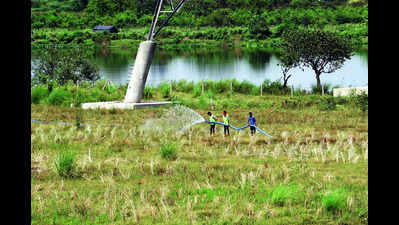- News
- City News
- delhi News
- Bamboo garden in Najafgarh to have 101 species
Trending
This story is from December 27, 2023
Bamboo garden in Najafgarh to have 101 species
The forest department is creating a bambusetum in Galibpur village in Najafgarh with the plantation of over 100 bamboo species from across the country. Another bambusetum is coming up at Baansera on the Yamuna floodplain. In total, 8,282 bamboos of 101 species will be planted in Galibpur village. The forest department has invited tenders. The Bharat Kunj bambusetum at Baansera has been developed with 53 species of bamboos. The North East Biodiversity Conservation and Research Center in Assam has provided the rhizomes for the Bansera project.

NEW DELHI: The forest department is creating a bambusetum in Galibpur village in Najafgarh with the plantation of over 100 bamboo species from across the country. This will be the second bambusetum in the city, with another coming up at Baansera on the Yamuna floodplain.
For the bambusetum in Galibpur, 8,282 bamboos of 101 species — 82 bamboos each of one species — will be planted in the village.
“Varied bamboo species will be planted here. It will help in conserving the good quality of bamboo species and will also aid in conservation of gene pool,” a senior forest official said, adding that the forest department has invited tenders.
The official claimed that the plantation of bamboo species on the Yamuna floodplain has shown good results. “We are expecting a similar result at Galibpur village,” he added.
Officials had earlier told TOI that monopodial bamboo species, Melocalamus indicus, had been planted all along the periphery of the Bharat Kunj. A total of 4,068 bamboo saplings have been planted along the outer boundary, while the internal state and Union territory boundaries are being demarcated using ornamental species mussaenda.
“It is an important component of Baansera, where numerous species of bamboos are grown together with a well-designed ex situ conservation approach. It will provide an opportunity to the people to see and appreciate the biodiversity elements of bamboo in the heart of Delhi,” an official had said earlier.
According to the forest department, about 250 species of bamboos are reported to be belonging to 23 genera in India. Of these, eight genera with 32 species are found in the peninsular India, the rest occurs in northeastern states. Just the Western Ghats has 23 taxa belonging to eight genera, out of which nine species are stated to be rare or threatened.
Among the bamboo species, which will be planted now, are Bambusa multiplex, Bambusa copelandii, Dendrocalamus gigantius, Dinochloa gracilis, Dinochloa mclellandi, Phylostachys bambusoides and Sczostachyumc apetalum.
For the Bansera project, the North East Biodiversity Conservation and Research Center, Assam has provided the rhizomes (planting material), which is mainly sourced from tropical and sub-tropical regions. An official had said bamboos were known for their fast growth and high carbon sequestration.
For the bambusetum in Galibpur, 8,282 bamboos of 101 species — 82 bamboos each of one species — will be planted in the village.
“Varied bamboo species will be planted here. It will help in conserving the good quality of bamboo species and will also aid in conservation of gene pool,” a senior forest official said, adding that the forest department has invited tenders.
The official claimed that the plantation of bamboo species on the Yamuna floodplain has shown good results. “We are expecting a similar result at Galibpur village,” he added.
At Baansera, the bambusetum, known as the Bharat Kunj, has been established in the shape of India over an area of approximately 12,000 square metres on the floodplain of the Yamuna. The Bharat Kunj has been developed by planting 53 species of bamboos from across the country, with 40 specimens of each species. In total, 2,120 bamboo saplings have been planted inside the bambusetum.
Officials had earlier told TOI that monopodial bamboo species, Melocalamus indicus, had been planted all along the periphery of the Bharat Kunj. A total of 4,068 bamboo saplings have been planted along the outer boundary, while the internal state and Union territory boundaries are being demarcated using ornamental species mussaenda.
“It is an important component of Baansera, where numerous species of bamboos are grown together with a well-designed ex situ conservation approach. It will provide an opportunity to the people to see and appreciate the biodiversity elements of bamboo in the heart of Delhi,” an official had said earlier.
According to the forest department, about 250 species of bamboos are reported to be belonging to 23 genera in India. Of these, eight genera with 32 species are found in the peninsular India, the rest occurs in northeastern states. Just the Western Ghats has 23 taxa belonging to eight genera, out of which nine species are stated to be rare or threatened.
Among the bamboo species, which will be planted now, are Bambusa multiplex, Bambusa copelandii, Dendrocalamus gigantius, Dinochloa gracilis, Dinochloa mclellandi, Phylostachys bambusoides and Sczostachyumc apetalum.
For the Bansera project, the North East Biodiversity Conservation and Research Center, Assam has provided the rhizomes (planting material), which is mainly sourced from tropical and sub-tropical regions. An official had said bamboos were known for their fast growth and high carbon sequestration.
End of Article
FOLLOW US ON SOCIAL MEDIA










